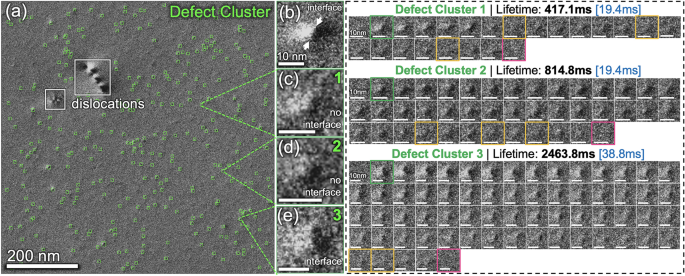コンピュータビジョンが科学実験のビデオ録画の価値を向上させる Computer vision expands the value of video recording science experiments
2023-02-16 アルゴンヌ国立研究所(ANL)
◆エネルギー省(DOE)アルゴンヌ国立研究所の核物質グループの主任材料科学者であるWei-Ying Chen氏は、人工知能(AI)の進歩を利用して、この状況を変えようとしています。最近発表された研究で詳述されているように、彼が動画からデータを抽出するために使用している深層学習ベースの多物体追跡(MOT)アルゴリズムは、米国が先進的な原子炉の設計を改善するのに役立つことを目的としています。その結果、原子力が近代化されれば、有害な温室効果ガスを放出することなく、安全で信頼できる電力をよりよく生産できるようになります。
◆現在、原子力エネルギーは、他のどのクリーンエネルギー源よりも少ない土地でより多くの電気を生産しています。米国の総電力の20%近くを供給する商業用原子炉の多くは、古い材料と技術を使用しています。科学者とエンジニアは、より新しい材料と高度な設計によって、原子力発電所によって生成されるクリーンな電力の割合を大幅に増やすことができると考えています。
◆チェン氏は、アルゴンヌの中電圧電子顕微鏡(IVEM)施設でユーザーを支援し、実験を行っています。これは、国家ユーザー施設で、DOEの原子力科学ユーザー施設(NSUF)のパートナー施設でもあります。IVEMは、透過型電子顕微鏡とイオンビーム加速器を組み合わせたもので、イオン照射による物質の変化をその場で見ることができる世界でも数少ない装置である。つまり、チェン教授のような科学者は、将来の原子炉で使用される予定の材料について、さまざまなエネルギーの影響を調べることができるのです。
◆IVEMのコンピュータビジョンは、監視カメラの映像から人を認識・追跡する顔認識ソフトと同様に、材料の欠陥や構造上の空隙を抽出するものです。顔のライブラリーを構築するのではなく、耐熱性、耐照射性、微細構造の欠陥、材料の寿命に関する膨大で信頼性の高い情報コレクションを構築するのです。この情報をプロットすることで、より良いモデルの開発や実験計画の立案に役立てることができます。
<関連情報>
- https://www.anl.gov/article/artificial-intelligence-reframes-nuclear-material-studies
- https://www.nature.com/articles/s41598-022-19697-1
DefectTrack: ディープラーニングを用いたマルチオブジェクト追跡アルゴリズムによるin-situ TEMビデオのリアルタイム定量欠陥分析 DefectTrack: a deep learning-based multi-object tracking algorithm for quantitative defect analysis of in-situ TEM videos in real-time
Rajat Sainju,Wei-Ying Chen,Samuel Schaefer,Qian Yang,Caiwen Ding,Meimei Li & Yuanyuan Zhu
Scientific Reports Published:20 September 2022
DOI:https://doi.org/10.1038/s41598-022-19697-1

Abstract
In-situ irradiation transmission electron microscopy (TEM) offers unique insights into the millisecond-timescale post-cascade process, such as the lifetime and thermal stability of defect clusters, vital to the mechanistic understanding of irradiation damage in nuclear materials. Converting in-situ irradiation TEM video data into meaningful information on defect cluster dynamic properties (e.g., lifetime) has become the major technical bottleneck. Here, we present a solution called the DefectTrack, the first dedicated deep learning-based one-shot multi-object tracking (MOT) model capable of tracking cascade-induced defect clusters in in-situ TEM videos in real-time. DefectTrack has achieved a Multi-Object Tracking Accuracy (MOTA) of 66.43% and a Mostly Tracked (MT) of 67.81% on the test set, which are comparable to state-of-the-art MOT algorithms. We discuss the MOT framework, model selection, training, and evaluation strategies for in-situ TEM applications. Further, we compare the DefectTrack with four human experts in quantifying defect cluster lifetime distributions using statistical tests and discuss the relationship between the material science domain metrics and MOT metrics. Our statistical evaluations on the defect lifetime distribution suggest that the DefectTrack outperforms human experts in accuracy and speed.



